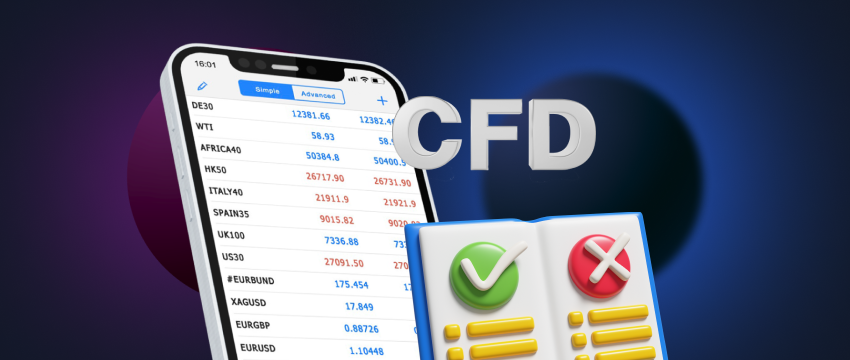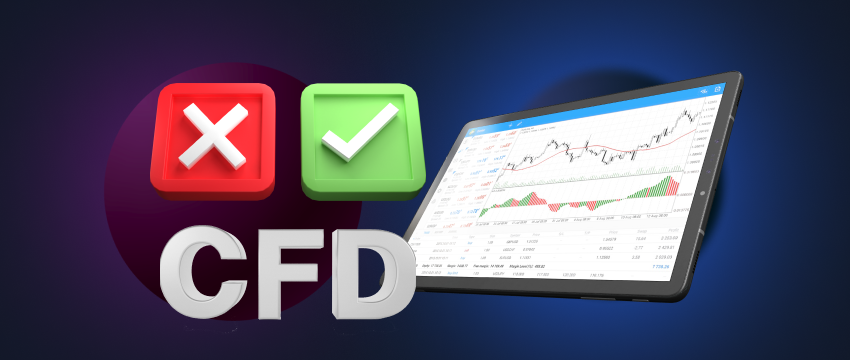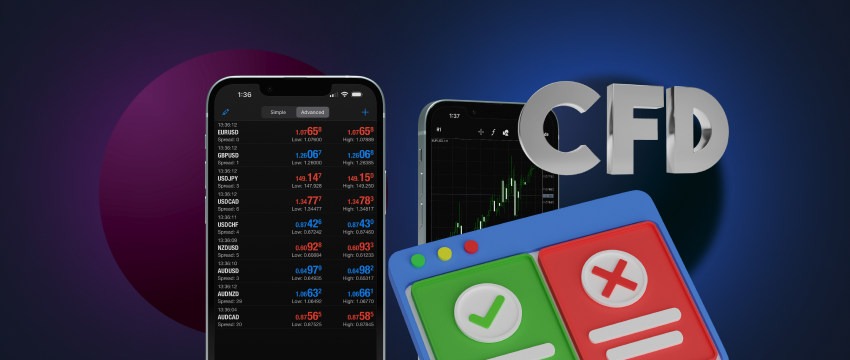Traders worldwide choose to trade CFDs for several reasons. CFDs offer traders a huge range of markets, the opportunity to use leverage, portfolio diversification, as well as the chance to capitalise on market movements, whether up or down. In this article, we’ll explore the pros and the cons of trading CFDs.
Pros of CFDs
CFDs are highly leveraged instruments
CFD traders can open or control a large trade position with less capital than what their account balance would usually allow. This exposure to greater trading opportunities, however, comes with high risk, especially if not managed properly. While leverage may amplify profits, it can just as quickly increase the possibility of large losses. Therefore, using proper risk management techniques such as stop-loss or take-profit orders is incredibly important.
Diversification of portfolio
CFD trading offers an effective method to diversify your trading portfolio. By choosing various CFDs based on their preferred underlying asset, such as cổ phiếu, currency pairs, hàng hóa, kim loại, you can participate in diverse financial markets and enter multiple trades, rather than just focusing on one. This reduces the risk of significant loss if that position moves in an unfavourable direction.
24/5 access to markets
CFDs provide traders with 24/5 access to thị trường tài chính across the globe. This means traders can react quickly to unexpected economic releases or news announcements as they occur. In other words, they can enter or exit positions faster and optimise potential profits where possible.
Speculate on price movements
CFDs are contracts entered between brokers and traders that allow trader to speculate on price movements of the underlying asset. Traders can make trading decisions based on these movements without owning the underlying asset, thus avoiding the cost associated with storing or insuring a physical asset.
Go long and short
CFDs allow traders to speculate on both rising and falling markets. In other words, you can go long or short, depending on market movement and/or sentiment. Furthermore, CFDs offer higher levels of liquidity. This means they can be traded on margin, allowing traders to enter and exit trades quickly and easily.

Hedging with CFDs
CFDs appeal to traders as they can be used for hedging. Hedging with CFDs involves taking an opposite position to your existing position in order to mitigate potential losses. This strategy aims to offset possible investment downturns.
It’s important to note that while CFD hedging can help minimise losses, it is not without risks. In addition to having a thorough understanding of CFDs, staying informed, consistently monitoring the markets, and implementing a proper risk management plan are just as important.
Drawbacks of CFD trading
Though CFD trading is an appealing form of trading, it comes with significant risk due to its volatile nature. Let’s look at some reasons why you might want to choose a different way to buy and sell financial markets.
Increased risk
CFDs can be traded with leverage, allowing you to control larger positions with a smaller initial deposit. However, while leverage can increase your profit potential, it can also increase your losses. This is because your profit or loss is calculated based on the full size of your position.
You don’t own the underlying asset
If your goal is to buy shares and own them within an investment portfolio, CFD trading may not be suitable for you. With CFDs, you never own the underlying asset, whether it’s a currency pair, commodity, or stock.
There are several reasons you might prefer owning assets. For instance, shareholders gain voting rights, allowing you to have a say over a company’s future direction. Holding a CFD does not allow you to do this.
Overnight financing
Keeping a CFD position open overnight incurs an overnight financing charge. This makes CFDs less suitable for long-term strategies, as the regular charges can decrease your profits or increase losses.
CFD trading and education
CFD trading and education go hand in hand, requiring more than just a strategic risk management plan. Ongoing learning is essential to gain a proper understanding of CFD trading and the risks involved. Here’s what trading education looks like:
- Webinars and live seminars. Experts and educators often host live webinars and seminars, providing insights, experiences, and trading techniques. These sessions allow real-time interaction and Q&A sessions.
- eBooks and blogs. There is a wealth of Sách điện tử and blogs on trading suitable for traders of different skill levels. These resources cover topics, ranging from basic concepts to advanced trading strategies.
- Podcasts and videos-on-demand. Traders can access podcasts and videos to learn more about CFD trading. They are great educational resources as they offer insights into different trading strategies.

Opening a demo trading account
An effective way to learn about and practice CFD trading is by signing up for a demo trading account. For instance, opening a demo account with T4Trade gives you access to a simulated trading environment.
Using a demo trading account with a reputable broker allows you to implement your CFD trading strategies, identify strengths and weaknesses, and make necessary changes. Using virtual funds, you can open and close CFD trades under real life market conditions, gaining a better understanding of CFD trading without losing any of your capital.
This gives you the time to focus on learning instead of worrying about your funds. A demo trading account also gives you the chance to learn about technical and fundamental analysis. Both have a great impact on your understanding of the markets and the way you execute your trades.
In addition, the demo account will introduce you to trading platforms like MetaTrader 4, favoured by global traders for its comprehensive features suitable for traders of all levels. Over time, this experience will build your confidence as well as the knowledge and experience necessary to move to a live trading environment.
Why become a T4Trade trader?
T4Trade appeals to traders worldwide globe due to its high-quality service offering, including a variety of tailored account types, flexible leverage, quick deposits and withdrawals, fast execution of orders and competitive spreads. This offering is complemented by a dynamic client support team available 24/5 to help traders with all their queries. The multilingual support team can be reached through communication channels such as live chat and email.
T4Trade also optimises their traders’ trading experience with its advanced MT4 trading platform, offering tools and features to increase the chance of success in CFD trading. This includes innovative analysis tools, algorithmic trading, charts, economic indicators, and more. As we’ve already mentioned, T4Trade’s Academy further supports your CFD trading education, helping you to become a more skilled CFD trader.

In summary
CFD trading offers a number of pros, including leverage, portfolio diversification, 24/5 market access, and the ability to speculate on price movements and both rising and falling markets. However, CFD trading also comes with significant risks, such as increased exposure to losses due to leverage, no physical ownership, and overnight financing charges.
By opening a demo account and using the resources provided by brokers like T4Trade, you can improve your knowledge and skills, making informed decisions to optimise your trading experience. Always remember, CFD trading involves risks, and decisions should be based on thorough research and understanding the markets.
Khước từ trách nhiệm: This material is for general informational and educational purposes only and should not be considered investment advice or an investment recommendation. T4Trade is not responsible for any data provided by third parties referenced or hyperlinked in this communication.




